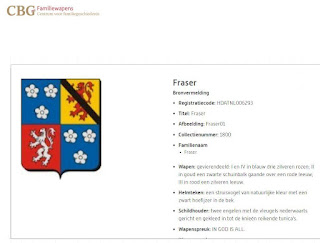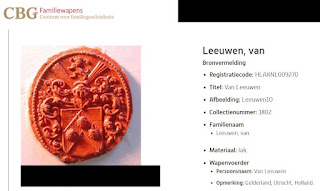Coat of arms on wax seal stamps,
Collection: Delta 98 Den Haag, The Hague, The Netherlands
donderdag
unknown but....... Curtius, Kurz, de Cort, Kortum, Korten, Kort, Cort, Kurs .........
woensdag
known: Vrijland and Fraser of Saltoun, Lords of Philorth and Fraserburgh
two wax seals from the estate of:
Liesbeth / Elisabeth Margaretha Julia Vrijland (1955-2021),
daughter of Cornelis Wilhelmus Derk Vrijland (1916-2012)
and
Bartha / Adriana Engelbartha Fraser (1918-2006)
- this Fraser wax seal is sold to an US collection -
see here below no. 17 (click to enlarge)
zondag
known: two brothers Van den Bergh marry sisters Cock and the lamb or cow of the family Crucius
an 18th century iron fob or wax seal pendant,
known as a SWIVEL, with triple matrix, a scrollwork frame and
a central clutch to push down to hold the to be used matrix in place,
we see:
a conjugal coat of arms, for a marriage
I. a castle with towers and reversed flags / vanes of the family
Van den Bergh / Berch
II. a bend between two escallops of the family
Cock
for the marriage in 1746 of
Pieter Van den Bergh (1708-1783) and Johanna Hadewich Cock (1702-1768)
no children documented
or
Jan Van den Bergh (1707-1737) and Adriana Geertruid Cock (1705-1734)
their daughter, Cornelia Helena Van den Bergh (1733-1741), died at the age of 8
Pieter and Jan were sons of
Isaac Van den Bergh (1677-1728) and Cornelia van Leeuwen (1675-1753)
Johanna Hadewich Cock and Adriana Geertruid Cock were daughters of
Mattheus Cock and Hendrica Cornelia Bouman,
and perhaps the above: no children and early deaths, might explain the empty third matrix
a coat of arms, quarterly with inescutcheon
I. Van den Bergh - a castle with towers and reversed flags / vanes
III. Crucius - per fess in green a lamb, also refered to as a cow and a cross pattee
for mothers side of Isaac Van den Bergh:
Sara Crucius (1651-1687)
she married in 1675 with Christoffel Van den Bergh (1639-1719)
Crucius is also documented as: Kruisius, Crutius, de la Croix
IV. Reijnders / Reynders - in gold, a double headed eagle
for mothers side of Cornelia van Leeuwen:
Anna Reijnders (1645-1699) married with Jan van Leeuwen
V. in blue / Azure two crossed swords
in Holland we found this coat of arms for: Riebeeck / Riebeek,
We think it might be derived from the coat of arms / armoirie / blason of
Jean de la Cour, seigneur De Buisson et vicomte de Caen or
the blason of Buisson de Champigny en France-Comte,
in Holland the French name De Buisson et de la Caen was probably written as
Debuissonet de la Cane
we found documented:
Maries des Marquis de Buissonet de la Cane (1599-1669),
she married in 1617 with Isaac van den Berch (1595-1665)
as supporters two lions rampant regardant
and topped with a five leaf crown
and beneath it all a ribbon with a small face,
the third matrix is vacant / empty
vrijdag
known: Raedt and Raedt van Oldenbarnevelt
antique wax seal stamp with the coat of arms of the family
Here above you can read at X., that
Antonis Readt van Oldenbarnevelt died in 1852
Some members of the Readt and Readt van Oldenbarnevelt family are burried on the estate in the woods called Kelderbos,
donderdag
known: Verschoor
an antique wax seal made of a beautiful cut brazilian agate, with the Dutch coat of arms of
Verschoor
a surname historical also known as: van der Schoer (date 1415), Schoir (date 1515), Ver Schoor, Schoor, Schor, van Schore, van Schorre, van der Schoore, Schoore, van der Schorre, van der Schoor
the word "schoor" or "schorre" in Dutch means low land behind a dike near a river or sea, that was reclaimed from the water, related to the english word "shore"
There are many Verschoor family lines and several coat of arms, this coat of arms might have been introduced in 1657 after a marriage of
Nicolaas / Claes Verschoor van Nisse, Schout-Bij-Nacht under command of Admiraal Michiel de Ruijter
he married in 1657 with Mechteld van Benthem / von Bentheim / van Bentum, one of the Van Benthem's coat of arms is also an orb, but with the cross on top
above: Heerlijkheid Nisse / Heerlykheyt van der / Heerlyckheyt van den Nisse
in 1793 Cornelia Wernerina Spijker, Vrouwe van Nisse and Vrouwe in Sinoutskerke en Baarsdorp (1773-1844) married with Jan Hendrik Verschoor (1769-1843), some descendents were Reinier Jan, Jan Reinier Frans and Caroline Agnita Verschoor van Nisse
sold by Delta 98 Den Haag
to a descendent of Verschoor van Nisse in The Netherlands
woensdag
unknown
an antique wax seal with a 16th or 17th century coat of arms
sold by Delta 98 Den Haag,
now in a private collection in Canada
with on I. and IV. a merchant's mark,
in Dutch called:
Huismerk - Handmerk - Sibbeteken - Familiemerk
on II. and III. a cauldron,
here a 16th - 17th C. cooking pot on three feet,
with ears and a handle / grip, in Dutch called:
ketel - kookpot - grape - pot - aker - graap - stoofpot - brouketel,
we could not find this specific merchants mark, there are very many, f.e.
maandag
known: Coerman
an antique wax seal with coat of arms, sold by
Delta 98 Den Haag
with a 17th Century boot
Coerman
- a shield of gold with a boot, as crest a barred helmet with a goat -
because the provenance is a collection of seals from
Van Alderwerelt and Heldewier it might have been passed down by
Gijsbertus Johannes Coerman
to his daughter Maria Henriette Arnoldine Coerman
who married in 1839 with Daniel Ocker Heldewier
in goud een laars, helmteken halfaanziend met een uitkomende bok
now in a private collection in Canada
zaterdag
known: Van Nispen
This coat of arms was an easy one to find,
it belongs to the family Van Nispen





















































